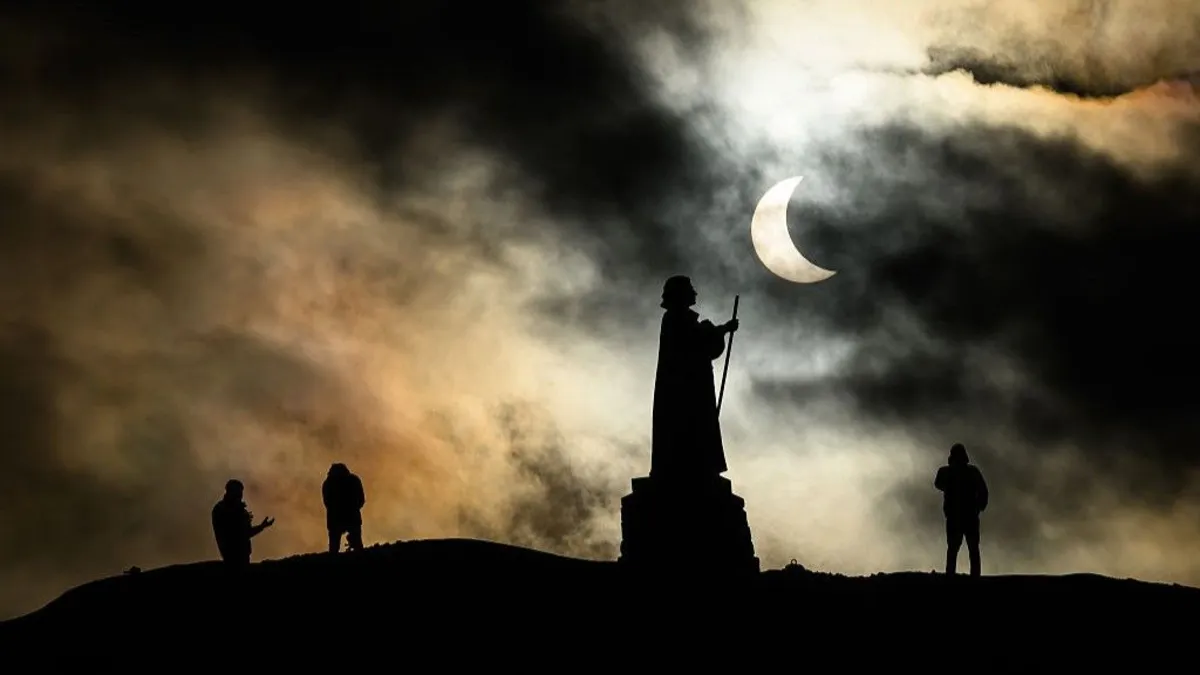
On March 29, a spectacular partial solar eclipse captivated skywatchers around the globe as the moon took a dramatic 'bite' out of the sun. This celestial event showcased stunning crescent-shaped suns, rare 'devil's horns,' and even a 'double sunrise,' leaving many in awe, especially those fortunate enough to be in optimal viewing locations. A partial solar eclipse occurs when the moon obscures a portion of the sun, resulting in a glowing crescent shape that can be observed safely with proper equipment.
The eclipse commenced globally at 4:50 a.m. EDT (0850 GMT), reaching its maximum peak at 6:47 a.m. EDT (1047 GMT). Skywatchers in regions across North America and Europe were treated to some of the best views of this stunning astronomical phenomenon. Unlike a total solar eclipse, where the sun is completely blocked, the partial solar eclipse required observers to utilize solar viewing equipment such as solar eclipse glasses or special solar filters on cameras, telescopes, and binoculars to ensure safe viewing.
This particular solar eclipse was especially memorable for many, including myself. It was truly the best one I have ever experienced! My previous encounter with the total solar eclipse in April was less than satisfactory, largely due to the uncooperative weather in the U.K., which often conceals celestial events behind thick clouds. However, on this day, I was prepared with a kitchen colander, solar eclipse glasses, and a pair of Celestron EclipSmart binoculars, allowing me to enjoy front-row seats to this marvelous solar display from Nottingham, U.K.
A striking photograph captured by Andy Moran in Nottingham showcased a sunspot in the upper left corner, as the moon gradually moved in from the right. The lunar eclipse that occurred just a week prior had been disappointingly clouded over, making the chance to watch and photograph this solar eclipse even more exhilarating, as noted by Moran in his remarks to Space.com.
At the iconic Stonehenge, the clouds graciously cleared just in time, providing breathtaking views of the eclipse over this ancient monument. Astrophotographer Josh Dury remarked in a video update how fortunate it was for England to enjoy such clear skies for this event.
The deep partial solar eclipse appeared magnificent over the statue of Dano-Norwegian Lutheran missionary Hans Egede in Nuuk, Greenland, as captured by photographer Leon Neal. Another stunning image from Nuuk illustrated a thin crescent sun as the moon covered a significant portion of the solar disk.
In France, the partial solar eclipse fought through cloud cover, creating a rather moody atmosphere. Nathan Stirk captured the moment at Keele Observatory in Keele, U.K., where skywatchers gathered to witness the eclipse. Additionally, photographer Paul Ellis took a striking image of the partial solar eclipse behind the iconic Liver Bird statue atop the Royal Liver Building in Liverpool, U.K. In northern Spain, spectators enjoyed the eclipse from the hill of Burgos' castle, watching through protective screens.
Another dramatic photograph emerged from the Municipal Cemetery of San Amaro in A Coruña, Galicia, Spain, showcasing the beauty of the partial solar eclipse on March 29, 2025.
If all this eclipse excitement has left you eager for more, there's no need to wait long for the next opportunity. A partial solar eclipse is on the horizon, set to occur on September 21, 2025. However, it's worth noting that this event will primarily be visible from remote areas in the Southern Hemisphere.
Feeling inspired to embark on a more in-depth moonlit adventure? Our ultimate guide to observing the moon will assist you in planning your next skywatching venture, whether you’re interested in exploring the lunar seas, mountainous terrain, or the myriad of craters that dot the moon’s surface.